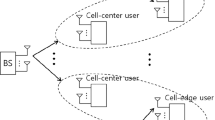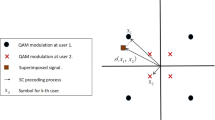Abstract
This work discusses a cluster-based non-orthogonal multiple access (NOMA) structures aiming at improving the system energy efficiency (EE) and spectral efficiency (SE) in a Massive MIMO (M-MIMO) cell through user clustering and power allocation strategies. Effectively, this work proposes an improved clustering-based NOMA M-MIMO structure under the EE-SE perspective combining the EE and SE performance metrics. In the considered power-domain NOMA M-MIMO configuration, the users are grouped into several clusters; hence, each beamformer serves the users at a specific cluster. The EE-SE tradeoff, namely resource efficiency figure of merit in a cluster-based downlink NOMA M-MIMO is evaluated considering the application of two power allocation strategies. Based on two different channel cluster-head selection strategies, namely the equivalent channel vectors (Type I) and the channel matrix singular value decomposition (SVD) (Type II), the cluster-head in each cluster can tremendously mitigate the intra-cluster interference. Numerical results demonstrate that the best system performance regarding EE-SE tradeoff occurs for MIMO NOMA Type I cluster-head selection with two users per cluster.







Similar content being viewed by others
Data Availability
The datasets used or generated by the authors will be available under request.
Notes
Devices’ loading is the ratio between the number of mobile users and the number of BS antennas.
Multiuser detection (MuD) implies additional power consumption and signal processing burden at UE terminal, despite the MuD ability to mitigate the inter-cluster interference at the UE device. Moreover, with single-user detection (SuD) in the NOMA context, we mean that only the data streams of users in the same cluster can be decoded and removed via SIC.
Aligned in terms of specific BS direction or angle of arrival/departure (AoA/AoD).
References
Wong, V., Schober, R., Ng, D., Wang, L.: Key technologies for 5G wireless systems. Cambridge University Press, Cambridge (2017)
Luo, F., Zhang, C.: Signal processing for 5G: algorithms and implementations ser. Wiley - IEEE, Hoboken (2016)
Ding, Z., Lei, X., Karagiannidis, G.K., Schober, R., Yuan, J., Bhargava, V.K.: A survey on non-orthogonal multiple access for 5g networks: research challenges and future trends. IEEE J. Sel. Areas Commun. 35(10), 2181–2195 (2017)
Liu, Y., Xing, H., Pan, C., Nallanathan, A., Elkashlan, M., Hanzo, L.: Multiple-antenna-assisted non-orthogonal multiple access. IEEE Wirel. Commun. 25(2), 17–23 (2018)
Tang, J., So, D.K.C., Alsusa, E., Hamdi, K.A.: Resource efficiency: a new paradigm on energy efficiency and spectral efficiency tradeoff. IEEE Trans. Wirel. Commun. 13(8), 4656–4669 (2014)
Huang, Y., He, S., Wang, J., Zhu, J.: Spectral and energy efficiency tradeoff for massive MIMO. IEEE Trans. Vehicular Technol. 67(8), 6991–7002 (2018). https://doi.org/10.1109/TVT.2018.2824311
Glei, N., Chibani, R. B.: Energy-efficient resource allocation for NOMA systems, In: 2019 16th International Multi-Conference on Systems, Signals Devices (SSD), pp. 648–651 (2019)
Selvam, K., Kumar, K.: Energy and spectrum efficiency trade-off of non-orthogonal multiple access (NOMA) over OFDMA for machine-to-machine communication, In: 2019 Fifth International Conference on Science Technology Engineering and Mathematics (ICONSTEM), vol. 1, pp. 523–528 (2019)
Tang, J., Luo, J., Liu, M., So, D.K.C., Alsusa, E., Chen, G., Wong, K., Chambers, J.A.: Energy efficiency optimization for NOMA with SWIPT. IEEE J. Sel. Topics Signal Process. 13(3), 452–466 (2019)
Wang, Z., Lin, Z., Lv, T., Ni, W.: Energy-efficient resource allocation in massive MIMO-NOMA networks with wireless power transfer: a distributed ADMM approach. IEEE Int. Things J. 8(18), 14 232-14 247 (2021)
Jacob, J.L., Panazio, C.M., Abrão, T.: Energy and spectral efficiencies trade-off in MIMO-NOMA system under user-rate fairness and variable user per cluster. Phys. Commun. 47, 101348 (2021)
Alves, T.A.B., Abrão, T.: Massive MIMO and NOMA bits-per-antenna efficiency under power allocation policies. Phys. Commun. 51, 101588 (2022)
Khan, W.U., Jameel, F., Ristaniemi, T., Khan, S., Sidhu, G.A.S., Liu, J.: Joint spectral and energy efficiency optimization for downlink NOMA networks. IEEE Trans. Cognitive Commun. Netw. 2, 1 (2019)
Saggese, F., Moretti, M., Abrardo, A.: A quasi-optimal clustering algorithm for MIMO-NOMA downlink systems. IEEE Wirel. Commun. Lett. 9(2), 152–156 (2020). https://doi.org/10.1109/LWC.2019.2946548
Kimy, B., Lim, S., Kim, H., Suh, S., Kwun, J., Choi, S., Lee, C., Lee, S., Hong, D.: “Non-orthogonal multiple access in a downlink multiuser beamforming system,” In: MILCOM 2013 - 2013 IEEE Military Communications Conference, pp. 1278–1283 (2013)
Ali, S., Hossain, E., Kim, D.I.: Non-orthogonal multiple access (NOMA) for downlink multiuser MIMO systems: user clustering, beamforming, and power allocation. IEEE Access 5, 565–577 (2017)
Spencer, Q.H., Swindlehurst, A.L., Haardt, M.: Zero-forcing methods for downlink spatial multiplexing in multiuser MIMO channels. IEEE Trans. Signal Process. 52(2), 461–471 (2004)
Muharar, R., Evans, J.: Optimal power allocation for multiuser transmit beamforming via regularized channel inversion, In: 2011 Conference Record of the Forty Fifth Asilomar Conference on Signals, Systems and Computers (ASILOMAR), pp. 1393–1397 (2011)
Peel, C.B., Hochwald, B.M., Swindlehurst, A.L.: A vector-perturbation technique for near-capacity multiantenna multiuser communication-part i: channel inversion and regularization. IEEE Trans. Commun. 53(1), 195–202 (2005)
Hoydis, J., ten Brink, S., Debbah, M.: Massive MIMO in the ul/dl of cellular networks: how many antennas do we need? IEEE J. Selected Areas Commun. 31(2), 160–171 (2013)
Wagner, S., Couillet, R., Debbah, M., Slock, D.T.M.: Large system analysis of linear precoding in correlated miso broadcast channels under limited feedback. IEEE Trans. Information Theory 58(7), 4509–4537 (2012)
Muharar, R.: Multiuser precoding in wireless communication systems. Ph.D. Dissertation, The University of Melbourne, Department of Electrical and Electronic Engineering (2012)
Ali, M.S., Tabassum, H., Hossain, E.: Dynamic user clustering and power allocation for uplink and downlink non-orthogonal multiple access (NOMA) systems. IEEE Access 4, 6325–6343 (2016)
Ali, M.S., Hossain, E., Kim, D.I.: Non-orthogonal multiple access (NOMA) for downlink multiuser MIMO systems: user clustering, beamforming, and power allocation. IEEE Access 5, 565–577 (2017)
Zafari, F., Gkelias, A., Leung, K.K.: A survey of indoor localization systems and technologies. IEEE Commun. Surveys Tutor. 21(3), 2568–2599 (2019)
Mohamed, E.M.: Joint users selection and beamforming in downlink milimetre-wave NOMA based on users positioning. IET Commun. 14(8), 1234–1240 (2020)
El-Sayed, M. M., Ibrahim, A. S., Khairy, M. M.: Power allocation strategies for non-orthogonal multiple access, In: 2016 International Conference on Selected Topics in Mobile Wireless Networking (MoWNeT), pp. 1–6 (April 2016)
Funding
This work was supported in part by the National Council for Scientific and Technological Development (CNPq) of Brazil under Grants 304066/2015-0, 310681/2019-7, and in part by the Londrina State University - Paraná State Government (UEL).
Author information
Authors and Affiliations
Contributions
All authors whose names appear on the submission. Made substantial contributions to the conception or design of the work; the acquisition, analysis, or interpretation of data; or the creation of new software used in this work; drafted the work or revised it critically for important intellectual content; approved the version to be published; and agrees to be accountable for all aspects of the work in ensuring that questions related to the accuracy or integrity of any part of the work are appropriately investigated and resolved.
Corresponding author
Ethics declarations
Conflict of interest
The authors have no competing interests as defined by Springer, or other interests that might be perceived to influence the results and/or discussion reported in this paper: The authors have no financial or proprietary interests in any material discussed in this article.
Ethical Approval
Not applicable.
Additional information
Publisher's Note
Springer Nature remains neutral with regard to jurisdictional claims in published maps and institutional affiliations.
Rights and permissions
Springer Nature or its licensor (e.g. a society or other partner) holds exclusive rights to this article under a publishing agreement with the author(s) or other rightsholder(s); author self-archiving of the accepted manuscript version of this article is solely governed by the terms of such publishing agreement and applicable law.
About this article
Cite this article
Rosa, K.B., Abrão, T. Improving the Resource Efficiency in Massive MIMO-NOMA Systems. J Netw Syst Manage 31, 74 (2023). https://doi.org/10.1007/s10922-023-09764-x
Received:
Revised:
Accepted:
Published:
DOI: https://doi.org/10.1007/s10922-023-09764-x




